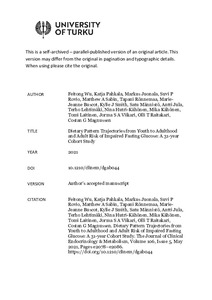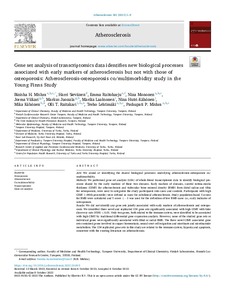Hae
Aineistot 1-10 / 13
Childhood and long-term dietary calcium intake and adult cardiovascular risk in a population with high calcium intake
<p>Background & aims</p><p>The influence of dietary calcium intake in childhood on adult cardiovascular health is unknown, particularly in those with long-term high intake. To examine both linear and non-linear associations ...
Dietary Intervention in Infancy and Cognitive Function in Young Adulthood: The Special Turku Coronary Risk Factor Intervention Project
<p><strong>Objective: </strong>Consumption of saturated fatty acids (SAFAs), polyunsaturated fatty acids (PUFAs), cholesterol, and fiber have been linked with cognitive function in adults. We evaluated these associations ...
Attainment of Targets of the 20-Year Infancy-Onset Dietary Intervention and Blood Pressure Across Childhood and Young Adulthood The Special Turku Coronary Risk Factor Intervention Project (STRIP)
We examined whether success in achieving the key targets of an infancy-onset 20-year dietary intervention was associated with blood pressure (BP) from infancy to young adulthood. In the prospective randomized STRIP (Special ...
Assessment of plasma ceramides as predictor for subclinical atherosclerosis
<p>Background and aims</p><p>Ceramides have been identified as novel biomarkers for cardiovascular disease (CVD) related events and mortality but their role in etiology of subclinical atherosclerosis is unknown. We aimed ...
Genetic and observational evidence: No independent role for cholesterol efflux over static high-density lipoprotein concentration measures in coronary heart disease risk assessment
<p>Background <br></p><p>Observational findings for high-density lipoprotein (HDL)-mediated cholesterol efflux capacity (HDL-CEC) and coronary heart disease (CHD) appear inconsistent, and knowledge of the genetic architecture ...
Dietary Pattern Trajectories from Youth to Adulthood and Adult Risk of Impaired Fasting Glucose: A 31-year Cohort Study
<p><b>Context</b></p><p>The influence of dietary pattern trajectories from youth to adulthood on adult glucose metabolism is unknown.<br></p><p><b>Objective</b></p><p>To identify dietary pattern trajectories from youth to ...
Association between Number of Siblings and Cardiovascular Risk Factors in Childhood and in Adulthood: The Cardiovascular Risk in Young Finns Study
<div><div><div><p><strong>Objective: </strong>To determine the association of number of siblings on cardiovascular risk factors in childhood and in adulthood.</p><p><strong>Study design: </strong>In total, 3554 participants ...
Repeatedly Measured Serum Creatinine and Cognitive Performance in Midlife: The Cardiovascular Risk in Young Finns Study
<p><strong>Background and Objectives</strong> Serum creatinine is typically used to assess kidney function. Impaired kidney function and thus high serum creatinine increase the risk of poor cognitive performance. However, ...
Gene set analysis of transcriptomics data identifies new biological processes associated with early markers of atherosclerosis but not with those of osteoporosis: Atherosclerosis-osteoporosis co/multimorbidity study in the Young Finns Study
<p>Aim<br></p><p>We aimed at identifying the shared biological processes underlying atherosclerosis-osteoporosis co/multimorbidity.</p><p>Methods</p><p>We performed gene set analysis (GSA) of whole-blood transcriptomic ...
The associations of oxidized lipoprotein lipids with lipoprotein subclass particle concentrations and their lipid compositions. The Cardiovascular Risk in Young Finns Study
<p>Objective<br></p><p>Oxidation of low-density lipoprotein (LDL) may promote atherosclerosis, whereas the reverse transport of oxidized lipids by high-density lipoprotein (HDL) may contribute to atheroprotection. To provide ...








